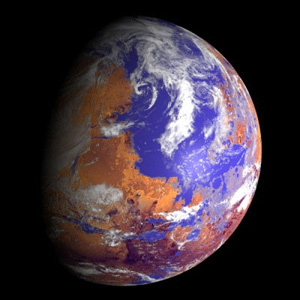 According to a statistical study by Arnuad Cassan of the Paris Institute of Astrophysics, there are potentially 160 billion exoplanets in the Milky Way.
According to a statistical study by Arnuad Cassan of the Paris Institute of Astrophysics, there are potentially 160 billion exoplanets in the Milky Way.
As of 2012, the Kepler satellite has discovered over 2000 exoplanets, including Kepler 20e and Kepler 20f, which are orbiting the Sun-like star Kepler 20. So the odds seem good for one of these worlds to have life on it.
Alien Planets
But what might an alien world look like? A distant ice world of glaciers and geysers? A desert land of subterranean colonies? We can make some good speculative guesses based on life on Earth. There are various external and internal factors that determine whether life can survive.
As with all homes, location is essential. You have to find the right kind of star. While there are billions of stars in the galaxy, only a fraction of them will be suitable for life. It needs to be in the correct spectral class range – a measure of the star’s temperature. It would have to have a lifespan of a few billion years to give time for life to evolve.
The luminosity of the star should also be stable, as fluctuations will result in potentially deadly waves of ionizing radiation. The star must be rich in metals for there to be a realistic chance of an exoplanet forming.
Viable exoplanets would have to orbit the star within a habitable zone. If they are too close to the star, they would be unbearably hot. Too far away, however and they will be too cold to support life forms more complex than simple microbes. The planet also can’t be too small or like Mars its gravitational pull would be insufficient to support an atmosphere. But if it’s too large it could retain such a huge atmosphere that the pressure on the surface would crush any potential life forms.
Life as we know it…
Once you have your suitably earth-sized world, at a suitable distance from a stable star, you’ll need an abundance of vital elements. 95% of all life forms on earth are made up of carbon, hydrogen, nitrogen, oxygen, phosphorus and sulphur. Include water to allow for metabolic reactions and you’ve got a chance of life occurring.
As for what this life would look like, it is very hard to imagine. Evolution favors the fittest and any evolved life form will be specific to the constraints of its environment. Various habitats on earth have evolved widely different species. The first Western explorers in Australia were amazed by kangaroos. Who knows what they would make of the natives of Kepler 20-e?
About the author: Nick Pateman is the webmaster for planets.org.uk, a website that helps to educate students about the planets, moons and dwarf planets in our solar system.